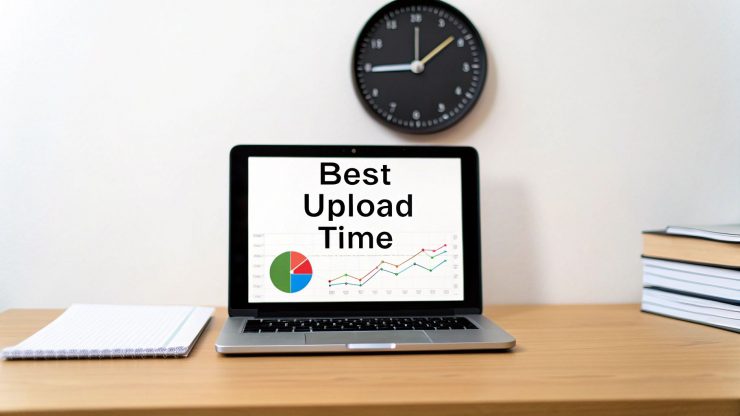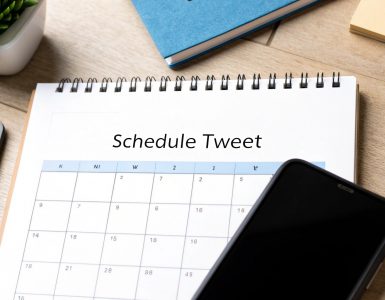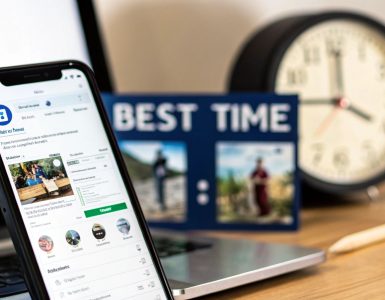In the competitive world of YouTube, creating great content is only half the battle. The other half is ensuring it reaches the widest possible audience. The timing of your upload can dramatically impact its initial velocity, the crucial wave of views, likes, and comments your video receives in the first few hours.
This initial engagement is a powerful signal to the YouTube algorithm. It heavily influences whether your video gets recommended to a broader audience or is simply lost in the digital noise. Many creators focus solely on production quality, overlooking the strategic advantage that timing provides. However, understanding the 'when' is just as crucial as perfecting the 'what'.
This guide moves beyond generic advice to deliver eight actionable, data-driven strategies to pinpoint the absolute best time to upload YouTube videos for your specific channel. We will explore how to leverage peak hours, analyze your own channel analytics for custom insights, and build a consistent schedule that turns casual viewers into loyal subscribers. By mastering your upload timing, you can give your content the launchpad it needs to succeed, maximizing reach and accelerating your channel’s growth.
1. Upload During Peak Audience Hours (2-4 PM EST)
One of the most widely accepted strategies for determining the best time to upload YouTube videos is to target the global peak engagement window. Publishing your video between 2:00 PM and 4:00 PM Eastern Standard Time (EST) allows you to capitalize on a crucial intersection of audience activity. This timeframe strategically captures viewers in North America during their afternoon break and simultaneously reaches European audiences as they unwind in the evening.

The primary benefit of this method is maximizing the "initial velocity" of your video. The YouTube algorithm closely monitors how a new upload performs in its first few hours. A strong initial surge in views, likes, and comments signals to the algorithm that the content is engaging, increasing its likelihood of being promoted on the homepage, in suggested videos, and to your subscribers. This principle extends beyond YouTube, as similar timing strategies are effective across different platforms. To dive deeper, you can explore the best times to post on social media for a broader perspective.
How to Implement This Strategy
This approach is particularly effective for channels with a diverse, international audience. Top-tier creators like MrBeast and Dude Perfect frequently use this afternoon EST window to ensure their videos launch with maximum impact across different continents. To apply this to your channel, follow these steps:
- Verify with Analytics: Before committing, navigate to your YouTube Studio Analytics. Under the "Audience" tab, check the "When your viewers are on YouTube" report to confirm if this 2-4 PM EST window aligns with your specific audience's activity peaks.
- Test and Optimize: Don't just set it and forget it. Experiment by scheduling uploads at 2:00 PM, 3:00 PM, and 4:00 PM on different weeks to see which specific time slot yields the best results for your content.
- Schedule in Advance: Use YouTube's scheduling tool to lock in your upload time. This ensures consistency and prevents last-minute rushes, helping you maintain a reliable publishing cadence for your viewers.
2. Tuesday Through Thursday Upload Strategy
Another highly effective strategy for determining the best time to upload YouTube videos involves focusing on mid-week days. Publishing content between Tuesday and Thursday leverages established viewer routines, capturing audiences after the Monday rush and before the weekend disconnect. These days often represent a sweet spot where people are settled into their weekly schedule and actively seek online content for education, entertainment, or a break from work.
The logic behind this approach is rooted in audience behavior. Mondays are often hectic, with viewers catching up on work and personal tasks. By contrast, from Tuesday to Thursday, engagement tends to be more consistent and predictable. This allows a new video to gain steady momentum without competing with weekend activities or the "Monday blues." Many educational channels and business-focused creators capitalize on this, knowing their audience is in a receptive mindset for learning or professional development during the workweek.
How to Implement This Strategy
This strategy is ideal for channels whose content aligns with professional or educational routines, such as tutorials, business insights, or in-depth analysis. For instance, educational powerhouses like Crash Course and Kurzgesagt often favor mid-week uploads to align with their audience's learning habits. To apply this method effectively:
- Identify Your Peak Mid-Week Day: Use your YouTube Analytics to compare the performance of Tuesday, Wednesday, and Thursday. Check the "When your viewers are on YouTube" report to see if one of these days shows a noticeably higher concentration of active viewers for your specific channel.
- Consider Your Niche's Cadence: A business channel might find Wednesday to be the best time to upload YouTube videos, as it’s the heart of the professional week. A DIY or hobby channel might see more success on a Thursday, as viewers begin planning weekend projects.
- Reserve Weekends for Community: Use your prime Tuesday-Thursday slot for major video uploads and save weekends for lighter content. You can post community polls, behind-the-scenes photos, or short-form content to keep your audience engaged without demanding the attention a long-form video requires.
3. Analyze Your YouTube Analytics for Audience Activity
While general timeframes provide a strong starting point, the most powerful strategy for determining the best time to upload YouTube videos is to consult your own data. Your YouTube Studio Analytics is a goldmine of personalized insights, revealing exactly when your specific audience is most active. This data-driven approach moves beyond educated guesses, allowing you to tailor your publishing schedule to the unique viewing patterns of your subscribers.
Using your channel's analytics eliminates the guesswork associated with time zones and audience demographics. For example, a gaming channel might discover its audience peaks late in the evening, whereas a fitness channel may find that early morning uploads perform exceptionally well as viewers start their day. This direct feedback loop is championed by analytics experts like Think Media and is a core lesson in the YouTube Creator Academy.
How to Implement This Strategy
This method is universally effective for any channel, regardless of size or niche, as it relies on concrete performance data. It is the most reliable way to find the optimal upload window tailored specifically for your community. To leverage this powerful tool, follow this process:
- Dive into Your Data: Navigate to YouTube Studio and click on "Analytics," then select the "Audience" tab. The key report here is the "When your viewers are on YouTube" chart. This graph visually displays the days and hours your viewers are most frequently on the platform.
- Identify Your Peak Times: Look for the darkest purple bars in the report. These represent the time slots with the highest concentration of your viewers. Aim to schedule your uploads one to two hours before these peak periods to give the YouTube algorithm time to index and start recommending your video.
- Cross-Reference with Top Videos: Go to the "Content" tab in your analytics and review your best-performing videos. Note their original publish dates and times. Cross-reference this information with your audience activity chart to confirm if your most successful content was launched during these peak windows.
- Update Your Strategy Quarterly: Audience behavior can shift over time due to seasonal changes, content trends, or growth in new regions. Make it a habit to review your analytics and adjust your upload schedule at least once every three months to stay aligned with your evolving viewer patterns.
4. Consider Your Global Audience Time Zones
For creators with a significant international following, pinpointing the single best time to upload YouTube videos becomes a complex puzzle of balancing time zones. Instead of focusing on one region's peak hours, this strategy involves identifying a "sweet spot" that serves multiple key audience segments simultaneously. The goal is to find a compromise time that captures viewers in different parts of the world as they are either starting their day, on a break, or winding down in the evening.

Successfully managing a global audience requires a deep understanding of your channel's specific demographics. For example, a creator like PewDiePie, with massive followings in both Europe and North America, must time releases to engage both markets effectively. This method ensures that no major viewer base feels consistently neglected, fostering a stronger global community and maximizing initial view velocity on an international scale. By strategically timing your posts, you are not just uploading a video; you are launching a global event for your subscribers. This is a core principle when learning how to use YouTube to market your website and build a worldwide brand.
How to Implement This Strategy
This approach is essential for any channel that has outgrown a single geographic market. Tech reviewers like Marques Brownlee (MKBHD) and educational channels often cater to a worldwide audience and must find upload times that work across continents. Here’s how to apply this to your channel:
- Identify Top Geographies: Go to your YouTube Studio Analytics and, under the "Audience" tab, find the "Top Geographies" report. Note your top 3-5 countries by viewership.
- Find Overlapping Hours: Use a time zone converter to map out the peak viewing hours for each of your top regions. Look for a time that is reasonable for the largest segments, such as late morning in the US, which corresponds to the evening in Europe.
- Rotate Upload Times: If a single compromise time is not feasible, consider rotating your upload schedule. Publish one video aimed at your American/European audience and the next one timed for your Asian/Australian viewers to serve all segments fairly over time.
- Monitor Regional Performance: After uploading, use YouTube Analytics to see how the video performed in different countries. This data will help you refine your global timing strategy and determine the most effective schedule for maximizing reach.
5. Upload 1-3 Hours Before Peak Viewing Times
A more nuanced strategy, popularized by YouTube algorithm experts and professional channel managers, involves publishing your video before your audience is most active. Uploading between 1 to 3 hours ahead of your peak viewing window gives YouTube's systems crucial time to process, index, and start distributing your content. This proactive approach ensures your video is ready to be served the moment your viewers log on.
This method works by front-loading the technical processes. When you upload, YouTube needs time to render the video in all resolutions (from 144p to 4K), analyze its content for categorization, and prepare it for the recommendation engine. By uploading early, you bypass this "cold start" and allow your video to gain initial traction. When your peak audience arrives, your video is already indexed and primed for discovery, leading to a much stronger performance surge. This is a key reason why understanding the best time to upload YouTube videos is about more than just matching peak hours.
How to Implement This Strategy
This strategy is ideal for creators who have identified a consistent and sharp peak in their viewership data. For example, if your analytics show a major spike at 6:00 PM, a 4:00 PM upload time would be perfect.
- Identify Your True Peak: Go to your YouTube Studio "Audience" tab. Pinpoint the exact hour your viewership consistently peaks. This is your target time.
- Establish a Lead Time: Start by scheduling your video two hours before that peak. For a 6:00 PM peak, upload at 4:00 PM. Monitor your video’s performance curve in the first six hours.
- Adjust and Test: Experiment with different lead times. Try uploading one hour before your peak, then three hours before. Compare the initial view velocity for each test to find the optimal pre-peak window for your specific audience and content niche.
- Factor in Notifications: Remember that subscribers get notified at the moment of publishing. An earlier upload can capture engaged super-fans, whose immediate interaction helps fuel the algorithm before the broader audience arrives.
6. Maintain a Consistent Upload Schedule
While finding the perfect hour can provide an initial boost, one of the most powerful long-term strategies for determining the best time to upload YouTube videos is simply to be consistent. Establishing a reliable upload schedule trains your audience, turning passive viewers into a loyal community that anticipates your content. This method prioritizes building viewing habits over chasing a single optimal time slot, as a dedicated audience will make time for your videos regardless of the exact upload hour.

The core principle behind this strategy is conditioning. When viewers know a new video from their favorite creator drops every Wednesday at 5:00 PM, they begin to integrate it into their weekly routine. This reliability builds trust and significantly boosts subscriber retention and engagement metrics over time. The YouTube algorithm rewards channels that consistently retain their audience, making schedule adherence a critical factor for sustainable growth. Creators like Casey Neistat famously built a massive following through a relentless daily upload schedule, proving that predictability can be more potent than perfect timing.
How to Implement This Strategy
This approach is ideal for any creator aiming for long-term channel health and community building. It shifts the focus from short-term algorithmic wins to fostering a dedicated subscriber base.
- Choose a Sustainable Cadence: Be realistic. It's better to consistently upload one high-quality video per week than to attempt a daily schedule and burn out. Start with a manageable frequency you can maintain for months.
- Batch Your Content: To avoid missing uploads, produce several videos in one or two sessions. This content batching creates a buffer, ensuring you always have a video ready to go, even during busy weeks.
- Communicate Your Schedule: Announce your upload schedule in your channel banner, video descriptions, and end screens. If the schedule needs to change, communicate it clearly and early to manage audience expectations.
- Plan with a Calendar: Use a content calendar to map out your uploads weeks or months in advance. This helps maintain organization and consistency. For a deeper dive into planning, you can explore resources on how to create a marketing calendar to keep your workflow streamlined.
7. Test Different Time Slots and Monitor Performance
While general guidelines provide a great starting point, the most powerful strategy for identifying the best time to upload YouTube videos is to adopt a scientific, data-driven approach. Systematically testing different upload times and carefully monitoring the results allows you to move beyond assumptions and uncover the unique engagement patterns of your specific audience. This method transforms timing from a guessing game into a repeatable, optimized process based on concrete evidence.
This analytical approach ensures your upload schedule is tailored precisely to when your community is most active and receptive. The core principle is to isolate the time variable to understand its direct impact on initial video performance. A well-executed test can reveal hidden pockets of high engagement you might otherwise miss, giving you a significant competitive advantage and maximizing the reach of every video you publish.
How to Implement This Strategy
This strategy is essential for any creator serious about growth, from emerging channels trying to find their footing to established brands looking to fine-tune their results. Data-driven creators and marketing analytics professionals champion this method for its reliability. To apply this to your channel, follow these steps:
- Isolate One Variable: To get clean data, test only one variable at a time. For instance, keep the day of the week (e.g., Friday) and the content format consistent, but vary the upload time (e.g., 9 AM, 1 PM, 6 PM) over three consecutive weeks.
- Run Extended Tests: A single upload is not a sufficient sample size. Run your tests for at least 4-6 weeks to gather enough data for statistical significance, which helps account for random fluctuations in viewership.
- Maintain Content Quality: Ensure the quality and topic of your videos remain consistent throughout the testing period. A sudden viral hit or a poorly performing video can skew the results, making it difficult to determine if the time slot or the content itself was the deciding factor.
- Document Everything: Keep a detailed log of your tests in a spreadsheet. Track the upload day, time, video topic, and key metrics like views in the first hour, first 24 hours, click-through rate, and average view duration. This documentation will be invaluable for future reference and decision-making.
8. Avoid Major Event Conflicts and Holiday Periods
Beyond your channel's specific analytics, a truly strategic approach to identifying the best time to upload YouTube videos involves looking at the broader cultural landscape. Publishing your content during a major sporting event, a highly anticipated movie premiere, or a national holiday is like trying to whisper in a crowded stadium. Your video will be competing for a finite amount of audience attention that is being monopolized by a larger, more dominant event.
This method, often used by professional media planners and seasoned creators, focuses on maximizing visibility by avoiding "attention blackouts." When a significant event like the Super Bowl, the Oscars, or a major breaking news story unfolds, people's viewing habits shift dramatically. They are less likely to be browsing their YouTube subscriptions for new content. By strategically sidestepping these high-traffic periods, you ensure your video doesn't get lost in the noise, giving it a much better chance to capture your audience's focus and gain initial traction.
How to Implement This Strategy
This proactive scheduling tactic is essential for all channels, but particularly for those in the entertainment, commentary, or lifestyle niches where audiences are likely to be engaged with cultural events. For instance, a movie review channel would be wise to avoid posting a new review at the exact time a new Marvel blockbuster hits theaters.
- Maintain an Event Calendar: Keep a digital calendar that tracks major holidays, sporting championships (like the World Cup or Super Bowl), award shows, and significant industry-specific events relevant to your niche.
- Monitor Real-Time Trends: Before hitting "publish," take a moment to check trending topics on platforms like X (formerly Twitter) and Google Trends. If a major, unexpected news event is dominating the conversation, consider delaying your upload by a few hours or a day.
- Embrace Counter-Programming: Instead of competing, you can plan content around these events. For example, a food channel could post "Best Super Bowl Snack Recipes" a week before the game, not during it.
- Have Backup Content Ready: Unexpected events happen. Keep one or two evergreen videos ready to go. If a major global event forces you to postpone a time-sensitive upload, you can swap in the backup content to maintain your schedule without a loss.
8-Point YouTube Upload Timing Comparison
| Strategy | Implementation Complexity 🔄 | Resource Requirements ⚡ | Expected Outcomes 📊 | Ideal Use Cases 💡 | Key Advantages ⭐ |
|---|---|---|---|---|---|
| Upload During Peak Audience Hours (2-4 PM EST) | Medium (requires precise timing and discipline) | Moderate (consistent scheduling) | High initial views and engagement velocity | General entertainment and broad audiences | Maximizes initial engagement; proven effective globally |
| Tuesday Through Thursday Upload Strategy | Low (simple day choice) | Low | Higher engagement rates mid-week | Educational, professional, routine-based audiences | Lower competition; builds consistent viewing habits |
| Analyze Your YouTube Analytics for Audience Activity | High (requires data analysis skills) | Moderate (time investment analyzing data) | Most accurate, personalized upload timing | Channels with sufficient existing data | Data-driven decisions; tailored optimization |
| Consider Your Global Audience Time Zones | High (complex scheduling calculations) | Moderate to High (audience analysis) | Maximized global reach with 24-hour engagement cycles | International and multi-regional channels | Expands potential audience; builds international community |
| Upload 1-3 Hours Before Peak Viewing Times | Medium (requires precise timing) | Moderate (consistent monitoring) | Builds algorithm momentum for peak time discovery | Channels leveraging YouTube recommendation system | Allows early algorithm promotion; increases trending chances |
| Maintain Consistent Upload Schedule | Low to Medium (requires discipline) | Moderate (steady content production) | Builds loyal audience with predictable engagement | All content types needing audience retention | Creates habitual viewership; favored by algorithm |
| Test Different Time Slots and Monitor Performance | High (requires systematic testing) | High (time, analytics, patience) | Identifies unique optimal upload times | Creators focused on data-driven growth | Eliminates guesswork; adapts to audience behavior changes |
| Avoid Major Event Conflicts and Holiday Periods | Medium (requires event tracking) | Low to Moderate (planning needed) | Improved content visibility avoiding competition | Channels sensitive to external timing | Reduces competition; maximizes organic reach |
From Timing to Triumph: Your Next Steps for YouTube Growth
Finding the absolute best time to upload YouTube videos is less about discovering a single "magic hour" and more about adopting a strategic, data-informed mindset. We've explored a variety of tactics, from leveraging general peak hours like 2-4 PM EST to the critical importance of a consistent Tuesday-through-Thursday schedule. Yet, the most powerful insights will always come from your own channel's data.
The journey to mastering your upload schedule is an ongoing cycle of analysis, implementation, and refinement. Your YouTube Analytics is your roadmap, showing you exactly when your unique audience is online and most receptive to new content. By combining these personalized insights with foundational principles, like posting a few hours before peak viewing times and consistently testing different slots, you transform guesswork into a reliable growth engine.
Key Takeaways for Immediate Action
To turn these concepts into tangible results, focus on these core principles:
- Prioritize Your Data: General industry benchmarks are a fantastic starting point, but your channel's "When your viewers are on YouTube" report is your ultimate source of truth. Make checking it a weekly habit.
- Consistency Over Everything: The algorithm and your audience both reward predictability. A consistent schedule builds viewing habits and signals to YouTube that you are a reliable creator, which can boost your visibility.
- Think Like a Scheduler: Proactively avoid major holidays or global events (like the Super Bowl or World Cup final) where your content is likely to be drowned out. A simple awareness of the calendar can prevent a well-made video from underperforming.
- Test, Measure, Repeat: Don't be afraid to experiment. Try a new day or time slot for a month, carefully measure the results in the first 48 hours, and compare it to your baseline. This is how you fine-tune your approach for maximum impact.
Ultimately, determining the best time to upload YouTube videos is a crucial component of a larger system for success. Your timing strategy amplifies the reach of your content, but it works best when the content itself is compelling and aligned with your audience's interests. Remember that timing is just one piece of the puzzle; a strong content strategy is vital for sustained YouTube growth. Discover more powerful content strategy examples to inform your approach.
By embracing this process of continuous improvement, you move beyond simple scheduling and begin to strategically manage your channel's momentum. You create an environment where every video has the best possible chance to succeed, connect with your audience, and drive your channel forward.
Ready to maximize the lifespan of your video content? EvergreenFeed automatically reshares your best YouTube videos to your social media channels on a recurring schedule, ensuring they continuously reach new audiences long after you hit "publish." Stop letting great content go to waste and start your free trial of EvergreenFeed today.




